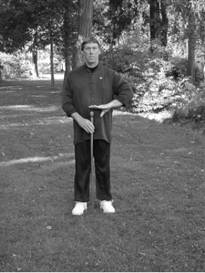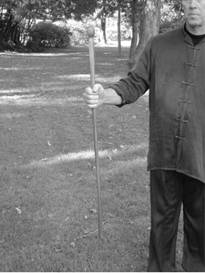 Gilman Studio On-Line Lessons
Gilman Studio On-Line Lessons
Tai Chi Partner Cane Form
This Lesson Contains:
Introduction
Welcome to the lessons for a very exciting and useful form – the cane, short stick, or Three Powers Stick Form. Firstly, I want to thank Sifu Andy Dale for teaching me the use of this short weapon. It has proven to be a useful weapon, and the form certainly contributes to proper body mechanics in the use of other sporting objects, like rackets, clubs, and bats.
I live in a small town on the Olympic Peninsula in Washington State. My wife and I go for walks in the evening after dinner. The streets are rather dark and there are no sidewalks on most streets. On one of our more frequent walks lived (his owners have since moved) a large dog that loved to come charging out at us as we calmly walked past his house. His hackles would come up and he would bare his teeth. We spoke to his owner, who thought there was nothing particularly wrong with this behavior since he had never bitten us, only disturbed our peace and gave us a good shot of adrenaline. We learned the dog’s name and tried to call his name as he attacked, but to no avail.
The night I came back from learning this cane form, I took a cane with me on our walk. We passed Sidney’s house, and he came charging out at us. I calmly pointed the stick at him, and with a firm voice said, “No, Sidney!” He looked at us and the stick and backed away. He never bothered us again. So there is my testimonial for the usefulness of this weapon. I was no longer at his mercy and he knew it. Even when I didn’t carry the cane, he let us alone.
There is an adage in China that goes something like, “Watch out for the old man who carries a stick.” In China people are not allowed to carry weapons. But due to over crowding and the love of the martial arts, there is a lot of fighting that goes on in the streets. So people carry their weapons in the form of canes, umbrellas, tools, and other everyday objects. This form explains the use of a very common object that no one will object to you carrying. Armed with the confidence of knowing how to use this tool, you will not feel vulnerable again. And a cane or walking stick is certainly useful in many other ways.
This form, like the two person saber application form, illustrates the principle of the three levels of attack and defense – namely high (head), middle (torso), and low (legs). These levels are effectively used in faking; causing the opponent to move his defenses to cover a perceived target, only to find the true target is somewhere else. This form certainly illustrates this important principle.
I hope you enjoy this two person form. This, like most two person forms, can be practiced as a solo form to great advantage. It is short, only 11 movements to a side. It is simple and straight forward. There are a lot of basic Tai Chi principles contained within.
Notice how the stances are not as deep as the solo form. This is because these movements must be done quickly with very light steps.
I will be teaching this in the same format that I taught the Saber Applications Form. The first part will show the applications, without worrying too much about the exact form. The second part breaks down carefully the two sides so you can learn the exact movements. The third part puts it all together and shows the form as performed by myself, Michael Gilman, and my partner in these lessons, Stephanie Morrell.
There is a 60 minute VHS video available through my on-line store to compliment this class. I’m sure you will want to have it, as it shows the exact form being performed and broken down into the same little pieces as the lessons that follow.
As always, feel free to contact me with any questions and comments. I sincerely hope you enjoy this form and find it useful. Good luck.
Note: Be sure to check out page two of this lesson for information on the traditional size and shape for the cane.

 1) The first picture shows the best height for the cane. The top should just reach your center.
1) The first picture shows the best height for the cane. The top should just reach your center.
2) The second picture shows the traditional design for a cane. Notice the round top, slender neck, and tapered body. The round top and slender neck make it easy to hold and difficult to pull from your grip. This cane was made for me out of a very hard wood and is quite heavy and strong. I would suggest starting with something light in weight, like bamboo. It should be as smooth as possible with no splinters. Some people enjoy finding small limbs from tress or bushes, or driftwood pieces are fairly easy to find. Do try and get a straight piece. I also have a collection of old canes and walking sticks that work alright and are fun to collect.
